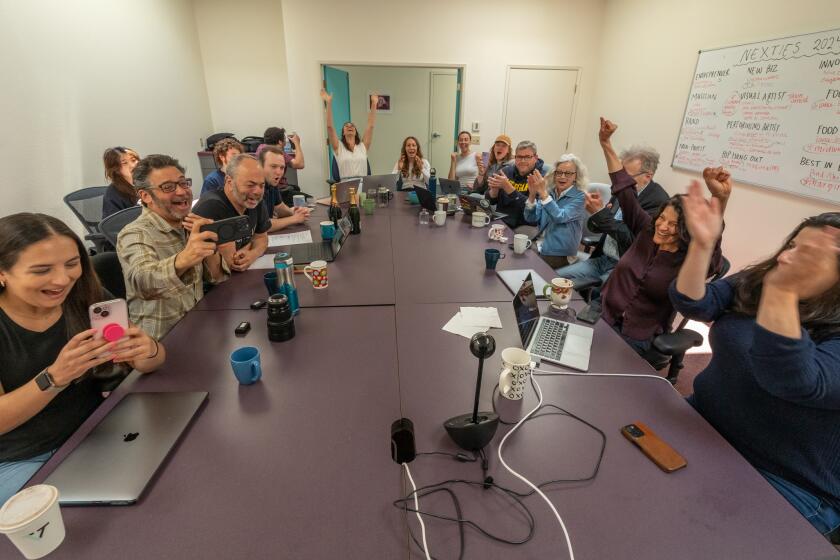City, County Programs Taking Shape : Poorest South L.A. Areas Ticketed for Development
Twenty-three years after the Watts riots focused national attention on the poverty of South-Central Los Angeles, large-scale economic development may finally be coming to the region’s poorest neighborhoods.
In complementary decisions, first the city and now the county of Los Angeles have tentatively approved plans that together could place more than 5,000 acres--or 8 square miles--of the Watts, Willowbrook and Florence areas in redevelopment zones by 1991.
Such moves, paired with business tax breaks in a new South-Central enterprise zone and a predicted industrial boom as the Century Freeway nears completion, could transform neighborhoods of boarded-up businesses and housing projects.
Old houses would be razed or renovated and new homes constructed. Business parks would line freeways and old water and sewer systems would be revamped, officials say.
The ambitious plans, however preliminary, have been a long time coming.
“Whether it was deliberate or as a result of market forces, this area has been overlooked,” David Lund, county Community Development Commission executive director, said in an interview.
“Now we are trying to do what redevelopment was designed to do,” he said, by bringing jobs to an area where unemployment is 25% and where half the households earn less than $9,875 a year, just 40% of the county median.
A year after the riots, the city formed a Watts redevelopment area of only 107 acres. Eleven years later, the county established the Willowbrook renewal zone a few blocks away on 365 acres. Together they are only one-tenth the size of the new zones initially approved in the last two months.
First, the Los Angeles Community Redevelopment Agency board approved a survey of 1,900 acres in Watts in late August, the first step in a process to create the largest redevelopment zone in city history.
Action by County
The county Board of Supervisors followed last week by authorizing a further study of 3,200 acres in impoverished unincorporated areas adjacent to Compton, Lynwood, South Gate, Huntington Park and Watts. If preliminary findings are confirmed and community support secured, the zone could be in place within 18 months.
Both new proposals are an outgrowth of discussions between the city and county, which began to work together to draw businesses to the Greater Watts area about two years ago.
Private industry has been reluctant to invest in the area for decades: government expenditure of $107 million in the existing Watts project area has prompted no private investment, according to the city.
But Lund predicts that Watts-Willowbrook “will be the next major redevelopment area in the Los Angeles Basin.”
Both the city and the county are counting on the 17-mile-long Century Freeway, which in 1993 will link Los Angeles International Airport with Downey’s aerospace industry and northern Orange County, to spur development of industrial parks along a 3-mile strip within the new zones.
Boost From Freeway
“The Century Freeway will continue to catalyze investment, and we’ll be the beneficiary of that,” Lund said. Once property is within a renewal zone, taxes on the value of all new construction go to the redevelopment agency for reinvestment in the community.
Regional planners say the new zones should also get a boost from two trolley lines now being built, one along the Century Freeway and the other running from Long Beach to downtown Los Angeles. The county’s new zone would also border the Alameda Street railroad corridor, which links Los Angeles with the booming ports of San Pedro Bay.
Those new or expanding transportation links, state and federal tax breaks through an overlapping business enterprise zone and the redevelopment agencies’ cut-rate sale of real estate to investors should all be powerful lures for private business, planners agree.
“That combination of transportation access, tax incentives and publicly owned land creates an enormous amount of leverage to stimulate investment activity,” said Mark Pisano, executive director of the Southern California Assn. of Governments, a regional planning agency that in 1980 predicted a future Century Freeway boom.
Pisano said he believes investment will spread from the freeway strip and the Alameda rail corridor into the broader community. City officials say that theory is supported by investor inquiries since possible expansion of the Watts zone was announced.
Looking for Opportunity
“Developers are calling, looking for warehousing opportunities not only along the freeway but in the project area,” said Bill Brown, manager of the city’s Watts project. “I think they’re very serious. . . . They are aware that redevelopment does have advantages as far as assembling land.”
Renewal agencies, which have the power to force the sale of property through condemnation, often buy individual lots and put them together before selling them at a fraction of their value to developers.
Developer Stanley Moore, who has built 15 business parks locally, said that once the city and county offer freeway sites for development “operators like me are going to have to line up and go like hell to get one.
“There’s nobody in our game that wouldn’t be excessively titillated by the size and the location of these (new zones),” Moore said. “I can’t wait to see what they come up with, because I’m sure we’re going to compete on it.”
However, the relative lack of vacant or easily developed land in the South-Central area may be the greatest shortcoming of the expansion plans, redevelopment officials say.
Many Aging Houses
Unlike older Southland freeways, where business parks sprang from farms and pastures, a large majority of the Watts-Willowbrook area is covered with aging houses.
“This freeway is cutting a swath through developed areas, so the depth (of land) available for new development is very shallow,” Brown said. “You move back a little, and you have houses that should be rehabilitated. Then you aren’t taking vacant land, you’re taking people’s homes.”
Brown cautioned that development within the city’s new Watts zone could be slow because the cost of buying existing buildings is too high. But substantial new construction should occur near the Century Freeway’s only off-ramps within the new zones--at the Harbor Freeway, Central Avenue and Alameda Street, he said.
Existing structures are less of a problem along the Alameda Street rail corridor, which is lined by patches of vacant land, junk yards, and a number of businesses so marginal their value is low, analysts say. In addition, a county study concludes that there is a demand for more warehousing and light industry along the corridor.
The same study says the South-Central area will support more small shopping centers, a position endorsed by developer Alexander Haagen, who built the Vermont-Slauson center in 1981 and participated in the construction of the large centers that opened in Watts in 1984 and Willowbrook in 1987.
“I think there’s still a tremendous demand in that area,” Haagen said. Profits are high at both Vermont-Slauson and Watts, and business is good at Willowbrook although it is not yet fully developed, he said.
Sources of Concern
No one is saying, however, that the success of the new zones is assured.
Banks are still reluctant to lend money for inner city projects and federal grants and industrial bonds are drying up, Haagen said.
Lund acknowledged that the county will have to “create demand” for new construction through incentives and land packages, then spend millions of dollars to rebuild sewer and water systems to accommodate the growth.
Some community leaders, aware that it took 20 years to lure a new supermarket to Watts, say they will believe in redevelopment when they see the buildings under construction.
Even then, they want to make sure regulations are in place that require the hiring of local residents for new jobs.
“I am not that enthusiastic about a major redevelopment plan, because I realize that in 23 years the small redevelopment area in Watts has not been completed,” said Ted Watkins, administrator of the Watts Labor Community Action Committee, a nonprofit organization that owns part of the Willowbrook shopping center.
While most employees at the new shopping centers are minorities, Watkins said he doubts that workers at industrial parks would be blacks and Latinos from his neighborhood.
A Chance for Jobs
“I’m looking at factories in the heart of Watts that don’t have one black working in them,” he said. “They operate behind walls and fences and closed doors.”
Officials say that enterprise zone tax breaks will go only to businesses that hire the unemployed. And they say the Watts and Willowbrook zones are already success stories.
In Willowbrook, the county’s 15-year-old Martin Luther King Jr./Drew Medical Center employs 2,700 people, and $18.5 million in public investment has been more than matched by private money since a redevelopment zone was formed in 1977.
Together, public and private agencies have paid for 56 new homes, the $23-million Willowbrook shopping center and a new water system. More housing and retail development should be under way by the end of the year, officials say.
“But by itself, Willowbrook is an island, and it can’t function particularly well unless we can do something else to support it,” Lund said. “We need to build on the Willowbrook success.”
More to Read
Start your day right
Sign up for Essential California for news, features and recommendations from the L.A. Times and beyond in your inbox six days a week.
You may occasionally receive promotional content from the Los Angeles Times.






